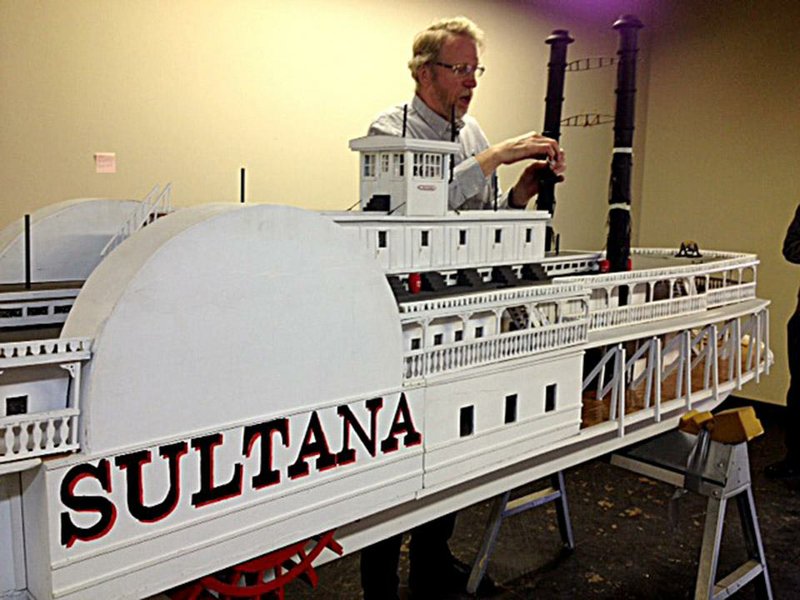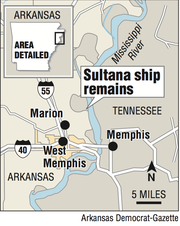MARION -- Gene Salecker's 14-foot replica of the 1865 steamboat Sultana is so detailed that it contains tiny spittoons for its crew members, rigging on its twin smokestacks for lanterns and a miniature alligator that the boat's captain actually kept on board as a pet.
Salecker, an eighth-grade social studies teacher from River Grove, Ill., spent two years creating the model of the ship, which exploded April 27, 1865, as it steamed up the Mississippi River near Marion. The blast killed more than 1,700 people, surpassing the Titanic's death toll by 300 and making it the worst maritime disaster in U.S. history.
He has donated his work to the Sultana Historic Preservation Society of Marion, which plans to display it with Sultana artifacts and history in a temporary museum across from the Crittenden County Courthouse until a permanent facility is built.
Salecker's intricate model includes small deck chairs, a stove in the pilot house and antlers mounted high between the smokestacks to indicate that it was a fast boat -- a custom seen on Mississippi River steamboats a century and a half ago.
His attention to the details falls in contrast to the relatively little coverage that newspapers gave the Sultana's explosion when it happened 150 years ago.
Most of the reporting then was focused on the April 14, 1865, assassination of President Abraham Lincoln and the manhunt for his killer, John Wilkes Booth. A funeral train carrying Lincoln's body traveled through the eastern half of the country, and papers carried reports of its progress. The Civil War had also just ended, so fresh reports carried information about the last days of the conflict and the release of war prisoners.
The Sultana was docked in Cairo, Ill., when Lincoln was killed. Crew members who learned of the assassination while ashore spread the word about the president's death as the boat headed downriver to New Orleans.
"It was the messenger of death," Salecker said. "Later, it became its own message of death."
On the boat's return trip, more than 2,000 Union soldiers released from Confederate prisons in Cahaba, Ala., and Andersonville, Ga., boarded the 260-foot Sultana at Vicksburg, Miss., on April 24, 1865, Salecker said.
The boat, which had an official capacity of only 376 people, was heading to Ohio. According to ship records, there were also 308 civilians on board, 97 cases of wine, more than 75 horses, 100 hogs and the 10-foot alligator that Capt. J. Cass Mason of St. Louis kept in a wooden crate as a boat mascot.
The Sultana docked in Memphis at 6 p.m. April 26, the day Booth was killed by New York cavalrymen.
Five hours later, the boat left Memphis, crossed the river to land in Arkansas and pick up 1,000 bushels of coal in Hopefield. It headed upstream about 1 a.m.
At 2 a.m., Salecker said, three of the four boilers that created the steam that powered the boat exploded, sending passengers wounded by the shrapnel and fire into the flooded Mississippi River.
There are a few theories why the boilers exploded, Salecker said. Some think it was sabotaged by someone who hid dynamite in the Sultana's coal bin. Under that theory, crew members stoked the boiler's heater with coal and unknowingly threw dynamite into the flames.
Salecker, however, believes faulty equipment was responsible. He's researched old records and found that Mason was running low on funds and could not afford needed repairs to the boiler. He added that the weight of the additional people may have caused the boat to tilt, causing water in the boiler to tip below its safety mark.
Salecker didn't know about the Sultana's history until he read a book about the boat and then attended an annual meeting held by relatives of survivors of the explosion in Knoxville, Tenn. He met Jerry Potter, a Memphis author who wrote a book about the boat, and the two began sharing information.
Salecker wrote his own book, Disaster on the Mississippi, in 1996 and has been interested in the boat's history since.
It took him two summers to build his replica. He loaded it in a U-Haul truck and made the eight-hour trip to Marion, where he reassembled it.
"This will draw a lot of interest to our museum," said Norman Vicker, president of the Sultana Historic Preservation Society. "We've got some markers in town, but this is amazing."
Vicker said the boat will be on display in the Washington Street building for about two years, along with artifacts found on the sunken boat, articles about the explosion and display panels that list the names of the Sultana's passengers.
"A lot of people didn't know about this happening here," he said. "This will help let them know."
Members of the society will meet later this month to discuss building a new museum in Marion. They also plan to hold a celebration April 27 to commemorate the explosion, which will include a re-enactment on the Crittenden County Courthouse lawn, a tour of the Washington Street museum and lectures by historians.
Salecker and Potter both plan to speak at the commemoration.
"It's so under-recognized," said Michael Demster, the president of the Marion Chamber of Commerce. "Hopefully, this will afford the Sultana its rightful place in history.
"There are so many layers to think about. You have the ending of the Civil War, Lincoln's assassination and his funeral train going through cities and the boat."
Demster said he's received calls from the History Channel, a cable television outlet that features historical documentaries and programs, other historians and those interested in traveling to the area to see where the Sultana exploded.
"It's the most obvious historical aspect of this area," he said. "There's a lot more interest in it than meets the eye. But there's never been a designated place to center the interest around before. We're trying to get our arms around all of this."
State Desk on 01/05/2015

